For a long time, Nissan’s Altima and Maxima sedans have been so similar it’s been hard to tell them apart – and not just in terms of their looks.
They’re almost exactly the same size – and for several years, they offered the same engine – Nissan’s 3.5 liter V6.
Now the Altima’s got a new engine – one not available in the Maxima.
It also offers AWD – something that’s not available in the Maxima or the two best-selling mid-sized family cars the Altima directly competes with – the Toyota Camry and the Honda Accord.
There’s more, too.
Including a larger trunk and more backseat legroom than the Maxima.
For thousands less.
What It Is
Like the Maxima, the Altima is a mid-sized sedan.
Unlike the Maxima, it’s available with Nissan’s new turbocharged/variable compression 2.0 liter engine, which replaces the Maxima’s V6 as the Altima’s optional engine.
Interestingly, this engine makes more torque than the Maxima’s much larger 3.5 liter V6 – and almost as much horsepower – while returning better gas mileage.
The Altima is also now available with AWD while the Maxima is (for the moment) front wheel drive only.
There is also the matter of MSRP.
The Altima starts at $24,100 for the base S trim – vs. $34,050 for the least expensive version of the Maxima.
The Maxima does come standard with the V6, but for about the same money, you can buy a top-of-the-line Altima Platinum with the high-powered, high-efficiency turbo 2.0 engine; or pay thousands less for a mid-trim SL with the turbo engine and AWD.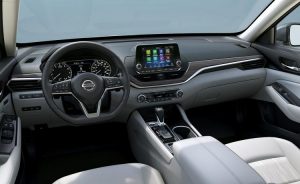
The larger-than-Maxima trunk – and roomier second row – are included at no additional charge.
What’s New
Nissan redid the Altima from the wheels up last year (2019 model year) so the ’20 carries over with just a few styling and trim tweaks.
What’s Good
Offers AWD in a class where it’s still inexplicably uncommon.
Offers almost as much power as much more expensive Maxima – for much less money.
USB ports for the backseat passengers.
AWD only offered with not-so-powerful standard (2.5 liter) engine.
Departed V6 (still available in the Maxima) was a simpler engine – no variable compression technology – and known to be a 200,000 mile engine. The new 2.0 has yet to prove itself as reliable.
And may prove not to be.
Under The Hood
You can go with the standard 2.5 liter four cylinder engine, which makes 188 horsepower – paired with a CVT automatic and your choice of of FWD or AWD.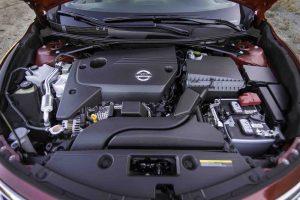
The Altima’s 2.5 liter engine makes slightly less power than the current Camry’s standard and class-leading 203 hp 2.5 liter four but within the margin of error vs. the current Accord’s standard 1.5 liter turbo four (192 hp) and the Mazda6’s standard 2.5 liter, 187 hp four.
Mileage with the Altima’s standard engine is very impressive: 28 city, 39 highway – the latter figure as good as many compact-sized economy cars.
For more power, there’s the new 2.0 liter turbo four, which makes 248 horsepower and 280 ft.-lbs. of torque at just 1,600 RPM. This is more torque and sooner torque than the Camry’s optional 3.5 liter V6 (267 ft.-lbs. at 4,700 RPM) and more torque – a little later – than the Accord’s optional 2.0 liter turbo four (273 ft.-lbs. at 1,500 RPM).
The Mazda6’s optional 2.0 liter turbocharged four makes the most torque (310 ft.-bs.) in the class – though a bit higher up the tach (2,000 RPM).
The Altima’s optional 2.0 engine is also paired with the CVT but is only offered in FWD configuration.
This is unusual.
Usually, it’s the stronger engine that’s paired with AWD – because of the additional weight of the AWD, which the additional power counterbalances – and because the AWD is better able to handle the additional power. Vey powerful (and very torquey) FWD cars tend to wheel-hop a lot.
But for reasons known only to the emperor – and Nissan muckety-mucks – the 2.0 engine isn’t available with AWD.
On the upside, mileage with this engine – 25 city, 34 highway is almost as good as with the much less powerful 2.5 liter engine.
And better than the Maxima’s V6 – which only manages 20 city, 30 highway.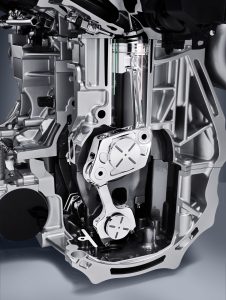
On the downside, it’s a weird engine, with a highly unconventional connecting rod arrangement that allows changes in stroke (how far the rod/piston travel up and down) to alter the engine’s compression as the engine runs.
Other engines have fixed compression ratios. Nissan’s variable compression concept – now variable compression actuality – gives the engine the flexibility to increase or decrease the compression ratio for more or less power (and more or less fuel consumption).
But how it holds up long-term to have connecting rods with what amount to joints (like your knee, which lets your leg flex out straight or bend) is for time to tell.
With the 2.5 engine, the Altima is economical. With AWD, it’s practical – a car that’ll get you to work when it snows.
With the optional 2.0 engine, it’s a performance car that’s also economical . . . just a bit less practical.
Nissan was among the first major car companies to go all-in on CVT automatics and theirs are among the best because they do among the best jobs of imitating the operating characteristics of non-CVT automatics.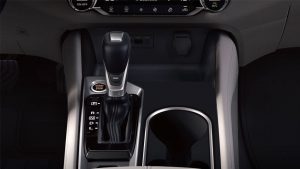
The transmission mimics the stepped gear changes of a traditional automatic – instead of buzzing the engine to high RPM and holding it there, as some CVTs do. But there’s no shift shock as the CVT steps from one range to the next; you can hold an open cup of coffee during full-throttle runs without having to turn around, go home and change your shirt.
Wheel-hop (and toque steer) with the optional 2.0 engine is there but you have to work for it. Unless you’re trying to get it to hop-skip left-right a little, it usually won’t. The variable-compression system works with the traction/stability control to modulate both power production and delivery.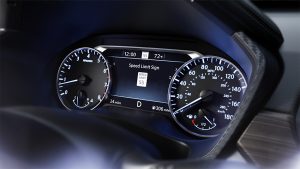
It feels as strong as the old V6, but doesn’t sound as good – the primary subjective criticism one can fairly level at the new engine.
BMW has the same issue with the 2.0 liter four it uses as the standard engine in the current 5-Series, which used to come standard with a six.
The tangibles – power/performance/mileage – are better. But the intangibles aren’t.
Nissan’s V6 is one of the best out there – and has been, for decades. Powerful, sweet-sounding and a rep as trustworthy as the pope’s.
It would likely be around for decades more . . . were it not for the Climate Change Cult and the fuel economy fatwas which are killing off engines larger than 2.0 liters in pretty much everything.
The Maxima is probably next.
Driving-wise, the Altima is more fun – even though the V6 is gone. It’s tuned for a more enthusiastic pace than the increasingly luxury-minded Maxima.
Get the SR for the most enthusiastic Altima. It comes with 19-inch wheel/tire package and paddle shifters for the CVT.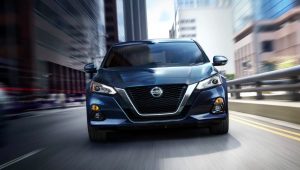
Nissan also offers a self-driving feature called ProPilot; it steers and brakes for you – a neat gimmick but also arguably dangerous as it encourages the driver to not drive the car.
Nissan – and everyone else offering this tech – is careful to characterize the tech as an “assist” and to warn the driver to maintain eyes on the road (and hands on the wheel) at all times.
But everyone knows this is fatuous. People are going to text/fiddle/sleep/have sex – anything but pay attention when they have tech in the car that drives it for them.
Just remember: If you wreck, the tech isn’t going to get the ticket – or the lawsuit.
You will.
The Altima looks a bit less rococo than its Maxima sibling, which may be preferable if you prefer a more subtle look.
The larger (15.4 cubic foot vs. 14.3 cubic foot) and noticeably roomier backseat (35.2 inches of legroom vs. 34.2 in the Maxima) are simply preferable – especially given you pay thousands less for both of these extras .
Interestingly, the Altima is now fractionally larger than the Maxima: 192.9 inches bumper to bumper vs. 192.8 inches for the current (2019) Maxima. Which will probably be upsized a little when Nissan brings out the updated (2020) version a few months from now.
One area of major departure – in the Maxima’s favor – is inside.
The Altima has a bland and derivative cabin compared with the Maxima’s. The main gauges – speedo and tach – are similar but everything else is profoundly not. For example, the Maxima has a less-afterthoughty secondary LCD cluster built into the center stack while the Altima has a generic-looking iPad mounted to the top of its center console. The Maxima’s center console flows upward into the center stack – while the Altima’s is a boxy bin bolted to the floor.
Perfectly functional – but in the manner of those cardboard thing they give you at fast food places to carry four drinks.
And then throw away.
On the upside, the Altima is more ergonomic. The controls for all the car’s functions are obvious and easy to work without having to take your eyes off the road.
The “zero gravity” seats are among the best out there. (Volvo’s are slightly better – but only slightly.)
Visibility is better-than-Maxima, too – because of the more restrained styling. The Altima’s about an inch taller than the Maxima – and so is its side glass. This doesn’t look as radical when viewed from the outside but it does make it easier to look outside the car – and notice other cars.
Another practical plus is the Altima’s wider-opening doors. They open to almost a full 90 degrees, which is helpful to those not-spry and also in terms of jamming stuff inside the car that might otherwise be more challenging to get in there. This is an important consideration in a sedan – most of which are functionally disadvantaged relative to crossovers of the same or even smaller overall size because of their limited ability to cart large/unwieldy items home.
With its larger than Maxima trunk – and it’s more accessible interior space – the Altima is a stronger contender vs. crossovers than the more stylish but less practical Maxima.
The Altima’s main appeal is its available AWD – which isn’t available in cross-shops like the Camry, Accord and Mazda6.
It’s odd that none of these offer AWD – given that AWD is offered in practically everything else. The fact that it isn’t probably accounts considerably for the dwindling popularity of sedans as a class.
And particularly, dwindling sales of Camry and Accord.
Not that AWD is all that – a set of good snow tires will take you almost anywhere in a FWD car . . . assuming you know how to drive in the snow.
Regardless, many buyers have been convinced they have to have AWD – even if they almost never have to drive in the snow. And if people want it and you’re not selling it, they’re not going to be shopping at your store.
It’s therefore startling that Toyota and Honda – for decades the sales leaders when it comes to family sedans – decided not to offer AWD when they rebooted their sedans last year.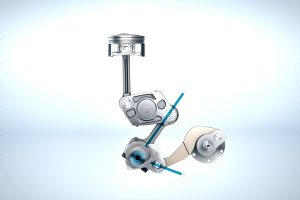
Nissan ought to send them both a thank-you card.
But, there’s that variable compression engine.
It’s a risk factor; the long-term unknown. AWD or not, the Camry and Accord are known things. And for many buyers, that may matter even more than the Altima’s available AWD.
The Bottom Line
Nissan has taken a gamble with its radical new engine – while also offering buyers something novel.
One offers more traction; it remains to be seen whether the other gets traction.
…
Got a question about cars, Libertarian politics – or anything else? Click on the “ask Eric” link and send ’em in!
If you like what you’ve found here please consider supporting EPautos.
We depend on you to keep the wheels turning!
Our donate button is here.
If you prefer not to use PayPal, our mailing address is:
EPautos
721 Hummingbird Lane SE
Copper Hill, VA 24079
PS: Get an EPautos magnet (pictured below) in return for a $20 or more one-time donation or a $10 or more monthly recurring donation. (Please be sure to tell us you want a sticker – and also, provide an address, so we know where to mail the thing!)
My latest eBook is also available for your favorite price – free! Click here. 


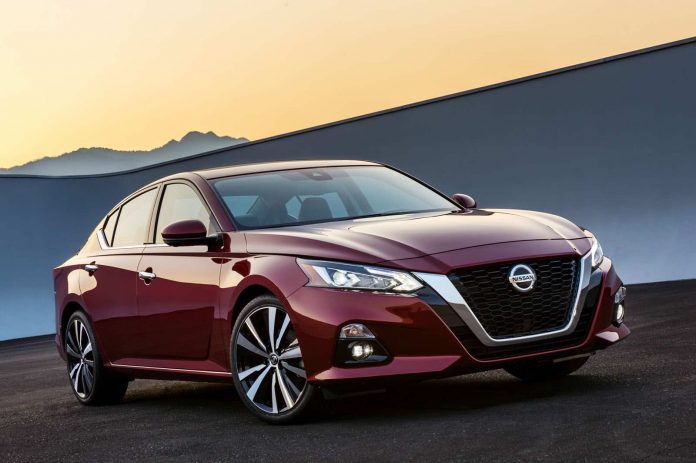


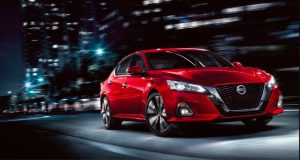
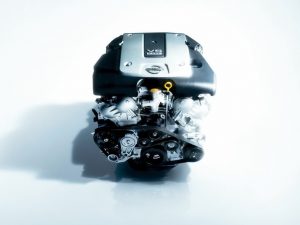


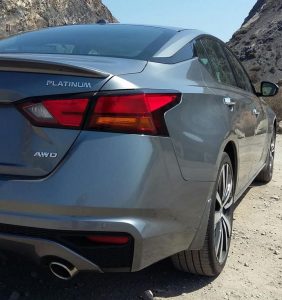








JATCO CVT
the end
Curious that you don’t mention the AWD CVT midsize sedan Subaru Legacy as a cross shop. It’s got a cheaper starting price too.
Hi J,
I probably should have; thanks for mentioning it!
I had the misfortune of driving a Legacy for almost 4 years. Mine was a 2010 model with 38,000 miles when I bought it. At first it was okay. I was looking for what I thought was a reliable car. For the first 20,000 miles, it didn’t give me much trouble. I had replaced the rear sway bar on it to give it better on highway behavior. The car had a tendency to become unstable when entering a freeway. The bar corrected it. At roughly 80,000 miles, I behan to hear a thumping noise from the front struts. The front strut mounts were bad adn I replaced them. The noise did not quit. I replaced the front sway bar links as a preventative. I went through at least two iterations of remove/replace before just gave up. At about 130,000 miles, the transmission light came on and the car wouldn’t move. It was due to a bad shift solenoid on the valve body. The problem was fixed for $1800 at the dealer. The alternator went out at 144,000 miles and the A/C was starting to act up. The car had some electrical gremlins as well from time to time. Switching out the headliht bulbs required dropping the fender liner. The CVT was lousy. It sounded like a blender. I will never own one of these cars again. I’m sure if I held on to the car, I would have been into it for a head gasket. These cars might do well in Colorado, driven once in a while, but not as a daily driver in Houston, TX. I will never own anothre Subaru for as long as I live.
swamp, my boss owns a repair shop. He’s about to turn 65 and said he was thinking about only repairing 99 and older vehicles. The new one have too much bs and require better scanners and more knowledge of what the scanners show and don’t show.
Plus we’re a pore county and even the cheapest cars out there are uber expensive to repair, very expensive parts….and not really for a good reason.
I said I’d work for him on 99 and older vehicles, esp. pickups. I can rebuild all the major parts and the minor parts like brakes aren’t expensive nor require specialty tools. I’m looking at the end of an era, a 98 Turbo Diesel that’s been worked pretty hard but the body’s good. I can use the body on my 93 with mechanical everything if need be. I’d rather have the 3500 I have than the 2500 which doesn’t have the 11.5″ rear end nor the heavy duty transmission and certainly not the 10″ frame.
I was told by the people at the Chevy body shop in early 2000’s that the frame on my 93 would take abuse the new ones wouldn’t survive. I had no reason to disbelieve them since they were straightening my frame.
I’m not a fan of roller lifters either. How many big rig diesels capable of going over 1.5 M miles or more have roller lifters? I realize they produce a lot more power with a “milder” cam but I don’t need to race or even drive a pickup over 100. The old 350’s in the early 90’s GM pickups would go over half a million miles. I’ve never heard of such with an LS engine. Even the 5.7L had roller rockers and cams and I don’t know of any of those that went over half a mil. I’ll stay with what is a known technology. The Dodge Hemi’s are experiencing roller lifter failure at low mileage. That’s easily a $2000+ repair.
The LS has variable valve timing and variable(this is the kicker)oil pump. They make a lot of HP for their size but I have yet to see one go the mileage of the old 350. I don’t think anyone will with the variable lifters and the oil pumps are known to have the bypass valve seize in the closed position=0 oil pressure.
I’m not the latest nor greatest and I don’t need that in a vehicle. And while a lot of people poo poo the old 6.5 Turbo Diesel, I have seen one with over 930,000 and still going and it was on its 3rd transmission(NVG 4500) but that’s a far cry from the cost of a new engine and it had spent it’s whole life pulling travel trailers and RV trailers from the manufacturer to the dealer or customer. I have never heard of any brand of new diesels doing that.
I can’t help but think of J Canell who had 960,000+ miles on a Cummins ISX and tore it down because of a cracked injector cup. He bought the parts to rebuild it and all the old parts measured the same as the new ones. Not even a brush on a piston skirt, no wear on the crank or cam. He was sorta miffed he opted to rebuild a perfectly good engine. He did something I’ve never heard anyone do though. On maintenance, he’d substitute a gallon of GL5 for a gallon of engine oil and changed every 22,000 miles. If it hadn’t cracked an injector cup he’d probably still be going after 2 million miles. And for reasons I don’t understand, cracked injector cups are not uncommon on high mileage big diesels. It would seem they’d want to fix that since it’s not limited to a particular brand although I don’t know of a Detroit 60 series with that problem.
Variable compression? No thank you. This is the exact opposite of what I want in an engine, simple, reliable, decent efficiency, easy maintenance…I can just see that monkey-motion crank drive after ~100K miles of hot weather stop-n-go driving. Varnish down South, and sludge up north in the winter will probably plug up the oil passages, and it’s goodbye monkey-motion bits!
Hi Crusty,
I’d be afeard, too. Much rather the V6….
Oh yeah. That is one of the truly great engines, the Nissan V6.
You talked me out of it.
I had my knees replaced sand they need (Kneed?) redoing after a lot less than 100.000 miles
The new variable compression engine is an interesting design. I saw a cutaway demo @ the NYC Auto Show 3-4 years ago. It uses like a bell crank to raise and lower the crankshaft, so as to vary combustion chamber volume. While it may offer better efficiency and performance, it’s yet another fancy thing to go wrong…
Interesting. I know that Saab had a prototype variable-compression engine back around 2000 but it never went into production. That engine used a split block with a pivot and hydraulic actuator rather than adjustable connecting rods.
https://en.wikipedia.org/wiki/Saab_Variable_Compression_engine
No way can I afford a new car (and wouldn’t want one of those rolling computers anyway), but not sure where I’d fall in the CVT versus conventional multispeed transmission debate. My main concern would be longevity and I don’t know whether a CVT or conventional 8, 9, or 10-speed trans would be better in that regard. (CVT seems conceptually a lot simpler.) I suspect either is suspect after the warranty expires.
Nissan has had their share of warranty fun and games with the Jatco CVT’s. But, to Nissan’s credit, they did stand behind them to ~120K miles, 100% warranty coverage. Unfortunately, lots of Versa and Altima owners ended up having to take advantage of Nissan’s warranty extension.
I’m OK with the CVT experience, even the “rubber band sensation” early ones. But, to this day, the reliability is not up to a good 3-4 speed planetary gearset auto. Unfortunately again, it’s almost impossible to find one of those 150K mile 3-4 speed autos anymore…they’re all 8-9 speed and horrendously expensive to replace. I’m not really sanguine about either auto type’s ultimate reliability nowadays.
I’m spoiled by the 3-speed Torqueflite in my ancient ride. Four decades of service without major repairs. When the time does come a trans of this type is not all that difficult or expensive (relatively speaking) to overhaul. I’ve even heard of shadetree mechanics doing it themselves. Unfortunately those days are way back in the rearview mirror when it comes to new vehicles.
Ah yes, the A904/A727 Torqueflite, the best auto trans ever made. Sigh.
I’ve done two auto boxes, personally. A MoPar 4-speed (A518) and a VW Type 003 3-speed auto transaxle. If you can do an engine, you can do one of those. Some ingenuity will even get around the need for a press to hold the clutch packs down long enough to get the retaining snap ring in/out. I’ve also replaced the solenoid pack in a MoPar 42LE 4-speed auto in a Dodge Intrepid. Not fun, but it can be done in the car.
Oh yes, no way I would overhaul one of these modern pieces of factory performance art!
In case you ever get the urge… 😉
https://www.youtube.com/watch?v=6oZD72lO7OI
Thanks for the link, that’s the CVT I am familiar with, the JF-010
What a crock of HOOEY! An input shaft speed sensor that is not self-shimming? Even Ma MoPar learned how to make speed sensors that are self-shimming. That’s a recipe for a very loud scraping sound, followed by bits of pole piece and sensor windings wrapped around the tone wheel!
Hi Crusty,
One of my favorite automatics is the one I retrofitted into my ’76 Pontiac. It’s the 2004R. This transmission was one of the early GM four speed overdrive automatics, as you probably know. What’s great about them is: Deep overdrive gearing (even with 3.90 rear gears, my Trans Am only tachs around 2,000 RPM at 60-something MPH) and no got-damned computer! Just a single 12V wire for the lock-up converter. It also was available in various bellhousing patterns for GM vehicles and so directly bolts up to old V8s like my Pontiac 455 (also Olds and Buick V8s) without an adaptor.
The early factory versions were not very strong, but this is easily fixed. Mine has survived my 455’s 500 ft.-lbs. of torque without spitting any parts for almost ten years now!
I never quite “got” the 200. I know that the 700 in the 700R4 is supposed to be because it will endure 700 hp. I’ve never seen rating for the 200. What’s the difference in the two?
Hi Eight,
Several, including physical: The 200 was designed when GM still made Olds/Pontiac V8 engines – and the Buick V6. So they made versions of it – “BOP” – to bolt right up to those engines without an adaptor. The 700 fits only the corporate Chevy bellhousing, though it can be adapted to others. The 700 also has a computer. The 200 is not electronic, other than the 12V lead for the lock-up converter. It’s much simpler and much more agreeable to swap in to an older car for this reason.
Hi Jason,
Those old three-speed automatics were top-shelf, except in one way: No overdrive. This forced a compromise choice: You could gear the car (in the pumpkin) for acceleration (0-60/quarter-mile) at the price of highway drivability and top speed, as well as gas mileage. Or you could put “highway” gears in the rear and have good gas mileage – and not so good acceleration.
That said, the TH350/TH400s were tough transmissions and also easy to rebuilt/replace for not much money.
Maybe the 400 was tough; not so much the 350.
There was actually a 375 produced although I never saw one advertised as such. It was a beefed up 350. I never had problems with 350’s and pulled some wicked loads.
I found out how to “wear one out” very quickly though. We had a range fire and a pickup I had had a big leak on the front seal. It was too low to move and since watching it burn up wasn’t my idea of a happy evening, I found out I was totally out of transmission fluid. I put some hydraulic fluid in it and it moved……twice. I didn’t think they were interchangeable but a range fire is a range fire. Oh well. I have another that I could use but I don’t want to mess with non-OD transmissions.
Well, I guess I never got a TH350 to completely quit, but they just got weaker and weaker in 4×4 pickups up in the 70K+ mile range along with depressing gas mileage. One of them (a hand-me-down) I sold because we needed a Suburban for the kids, and the other (previous) one I traded off for a new pickup with a manual four speed. It would have been far cheaper to just have it rebuilt, but at the time I was living out in the forest and only had one vehicle. Back then at least you couldn’t just rent a pickup to haul chainsaws and gas around in the woods, so I would have had to taken time off from work and stayed in town somewhere for however long a transmission shop needed to work on it.
The TH350 was certainly not “tough” compared to an SM420 or SM465 that would wear out a dozen engines. I guess in perspective, that K20 with the TH350 hauled 14K gross up to Alaska via the Cassiar “highway” which was really just a dirt trail back then.
Surprisingly I’ve had pretty good luck so far with the much-maligned 700R4 in the Suburban, but it hasn’t been used THAT hard.
The 400 and the 454 were often referred to as the “forever” transmission and engine. If you maintained them well I guess they were. I never wore out a 400 nor a 454 although I had a 454 have some severe problems since when I got it, you could take off the valve covers and not identify anything you saw. I don’t get people doing that. It did go a long way like that and with #4 intake valve burnt but it pulled trailers for many years just thump thump thumping. It finally jumped time to bad I gave up. It didn’t seem like rebuilding a 454 was worth it at the time. You could get raped on just a head job and that was just a slightly larger 350 head for all intents and purposes. You’d have thought the valves, guides and valve springs were made from unobtanium. I never quite understood that.
But none as tough as the king of (modern) automatics, the A727 Torqueflite. It could take anything from a 225 Slant Six in New York taxicab duty, up to the Elephant Mill itself, the monster 426 Hemi. Add a gear, and all of the sudden, you’re back to development engineering and owner-beta-testing again, sadly. It took MoPar and GM a couple years after introduction to get their 4-speed autos close in reliability to the A727 or TH350.
Yeah, GM done good with that non-computer-controlled 4-speed auto. MoPar had trouble with the early A518’s, too, with clutch pack burnouts. They got ’em fixed eventually, but not before GM got the TH200’s up to scratch. Excellent slushbox.
Oh yeah, not “modern” or light, or smooth, but really efficient…the granddaddy of them all, the GM Hydramatic. 4 speeds, fluid coupling (not a torque converter), even used them in tank duty in WW2. Had to be adjusted damn near constantly though to keep the shifts from snapping your neck off or making bits of the tranny go “BANG!”, but a very successful design.
I remember those well. My 55 Chevy pickup came new with one. By the time I bought it the odometer was yellow with age and had 99,000+ miles on it. By then it had a granny 4 speed, a truly indestructible transmission for the power back then.
I’ve heard that Nissan CVTs actually go into some kind of half-limp-in mode by softening throttle response, cutting power, holding a different RPM, etc. when thrashed for more than about 3-4 minutes at a time. I’ve also heard that at some point during the most recent decade, they switched to a different design of CVT which actually has less endurance and is more prone to going into pseudo-limp mode. Heck to the no!
Yeah, that happens when the trans temp sensor tells Mother ECU the tranny’s gone overtemp. I guess if you thrash it in the heat with a big enough engine (only had experience with a 1.8L Nissan 4-banger/CVT), you could get the thing to go OT. One funny about the early CVT’s, at least, they lock the torque converter very early and often, since the push belt drive allows easier ratio changes than a planetary gearset auto. That also means, if you make the computer unlock the TC frequently, the trans fluid will heat up quite a bit more than JATCO though proper, thus it goes into OT mitigation mode. Since the target demographic is cheap transportation and grannies (I guess), it’s probably OK. But for the rest of us…
I can only wonder what “thrasing” means. Is it 80mph on a day like day before yesterday when it was 104 outside?
I’m not going to describe what it means because that could get someone ratted. For now let’s just say that the ambient temperature was lower but the driving was much more intense with lots of hard acceleration.
There will NEVER be car with CVT parked in my garage. Honda and Toyota have proven that CVTs are not necessary to achieve optimum mpg…or any other drivetrain virtue. Their stodgy, frugal vibe is the perfect fit for Suburus….and for some reason, Nissan wants that too.
Cars with CVTs are like people who go through life wearing Crocs. And the people who choose to drive them probably are like that too.
Mike,
Especially one made by jatco. Garbage boxes. I think the paddle shifters are hilarious… lemme pretend shift gears😆🤣
I always thought the DAF Variomatic was pretty neat.
The only car that could go as fast in reverse as forward! Hub Van Doorne was a genius-grade engineer.
I love the DAF backwards racers!
https://www.youtube.com/watch?v=Req2qhhhgB4
Funny thing Jason. To this day, many of the steel belts used in JATCO and other CVTs are made by Van Doorne, the originator of the CVT. Love those crazy Dutch backwards racers, such pluck!
Exactly what I thought.
I beg your Pardo, Mike! CVT drivers are not Croc wearers, that (dis)honour is reserved for Pius drivers and their smug!